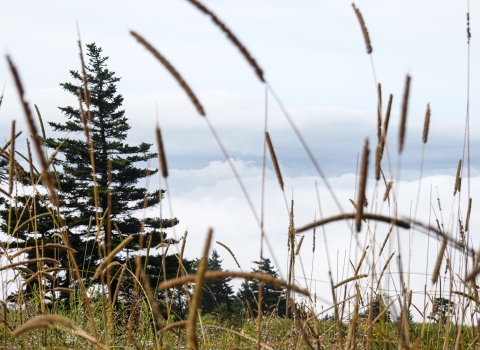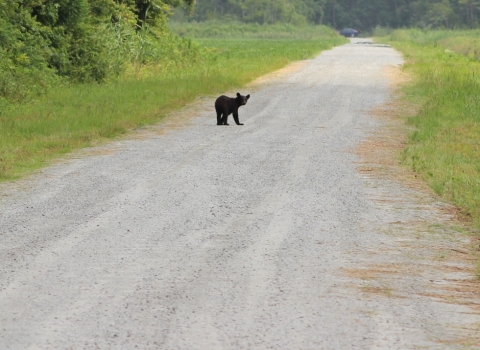There’s a certain level of intimacy you share with backcountry shelter-mates. You may have known them only a couple of hours. Maybe you don’t even know their name. But you quickly become familiar with their snoring.
And it was amidst snoring, bad camp food, and one brilliant sunset that the Asheville Field Office’s 2024 spider season came to a close.
Sue Cameron, biologist with the Asheville Field Office, is leading a six-year monitoring effort for the endangered spruce-fir moss spider – the most comprehensive ever undertaken for the spider. Year three just concluded with searches of two 10-acre plots in the backcountry of Great Smoky Mountains National Park - the most remote plots yet visited for the effort. Mark Endries and Gary Peeples, both of the Asheville Field Office, and spider expert Brian Bockhahn with N.C. State Parks, joined Cameron for the three-day trip into the backcountry.
Day one was marked by a nine-mile hike; a pre-packaged, off-the-shelf trail lunch that tasted marginally better than its unsightly appearance; arrival at the backcountry shelter that would serve as home base for the effort; and finally, a brilliant sunset.
Coming off a night rich in snoring, day two was all business - coffee and instant oatmeal, then bushwhacking across two, ten-acre plots, checking them for the spruce-fir moss spider. It’s a tiny animal, found only in the Fraser fir and red spruce forests atop the highest peaks of Southern Appalachia. It’s reliance on a cold, moist climate means it can serve as an indicator of ecological health in these areas with a very specific temperature and precipitation regime that may make them more susceptible to climate change climate change
Climate change includes both global warming driven by human-induced emissions of greenhouse gases and the resulting large-scale shifts in weather patterns. Though there have been previous periods of climatic change, since the mid-20th century humans have had an unprecedented impact on Earth's climate system and caused change on a global scale.
Learn more about climate change .
Some animals are fortunate enough to benefit from massive amounts of conservation effort, maybe even having an entire organization devoted to them. Not so the spruce-fir moss spider. Although it has been on the federal threatened and endangered species list since 1995, few people have taken interest and it never received much attention outside of a few sporadic surveys. This monitoring effort aims to track long-term trends in presence of the spider and its habitat across the six mountain massifs where it lives. Using a protocol developed at Clemson University, six plots are visited each year for six years – 36 plots total. This outing covered plots five and six for 2024, one yielding three spiders and the other, one. Far from the record, which is 11, but not zero, which is good in a situation where every individual counts.
An arriving weather front brought clouds, spoiling the second day’s sunset, though the mountaintop view was still good. The morning of the third day, we discovered the front also brought a steady, brisk, cold wind – an unwelcome feature on our hike out which started in the pre-dawn darkness. Off the trail by mid-day, the miles and wind made a hearty lunch taste all the better. The successful outing laid the groundwork for the summer for 2025, when two more plots that sit deeper in the Smokies backcountry are scheduled to be checked.





















